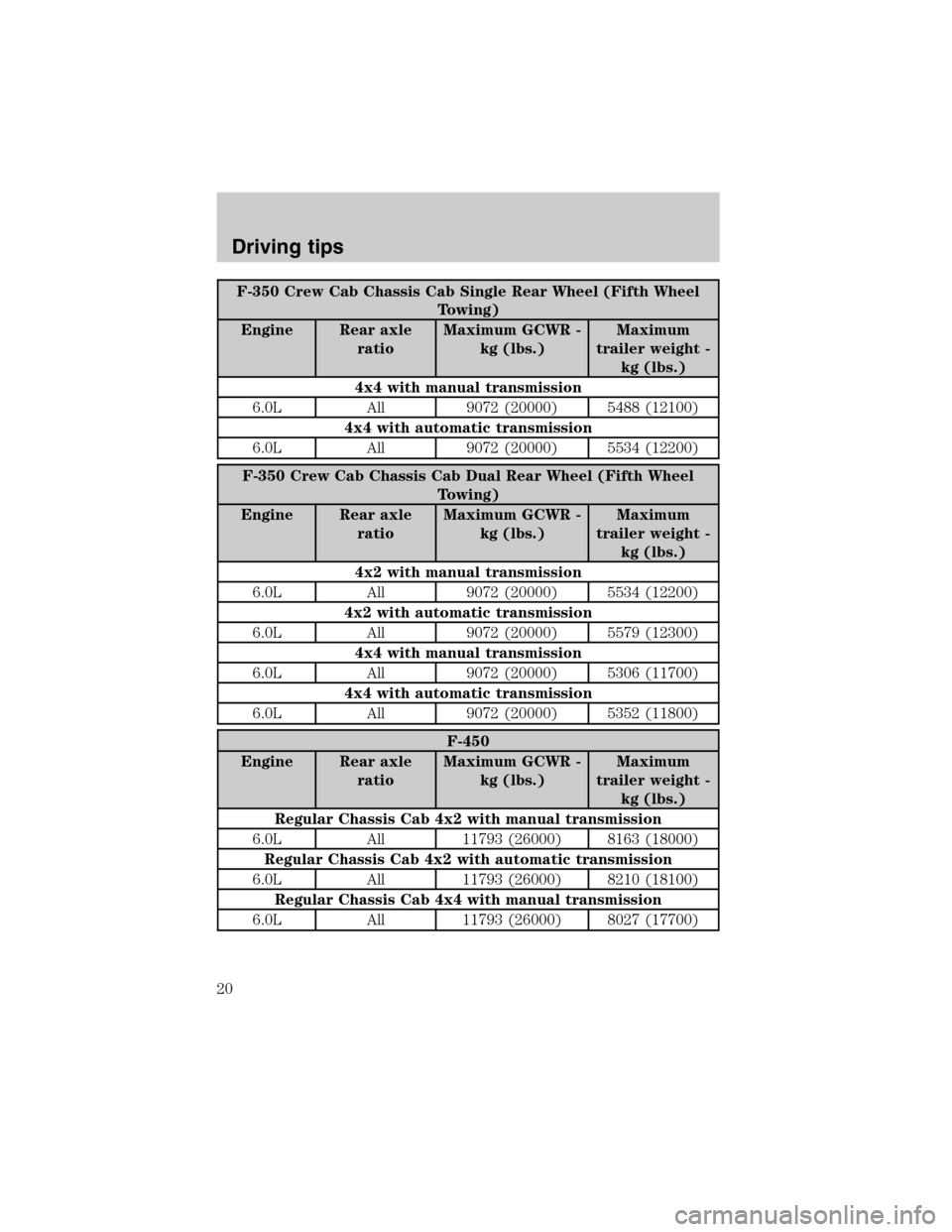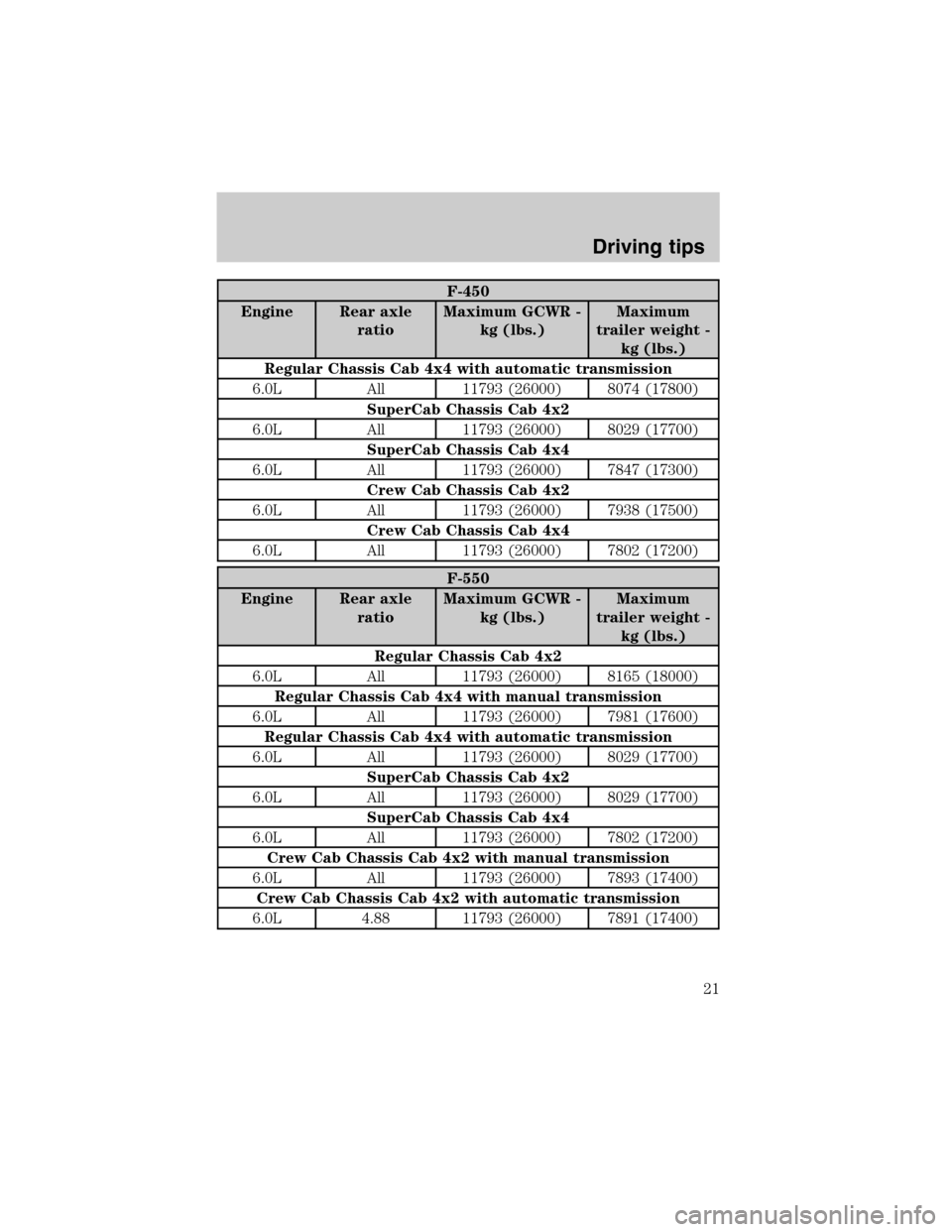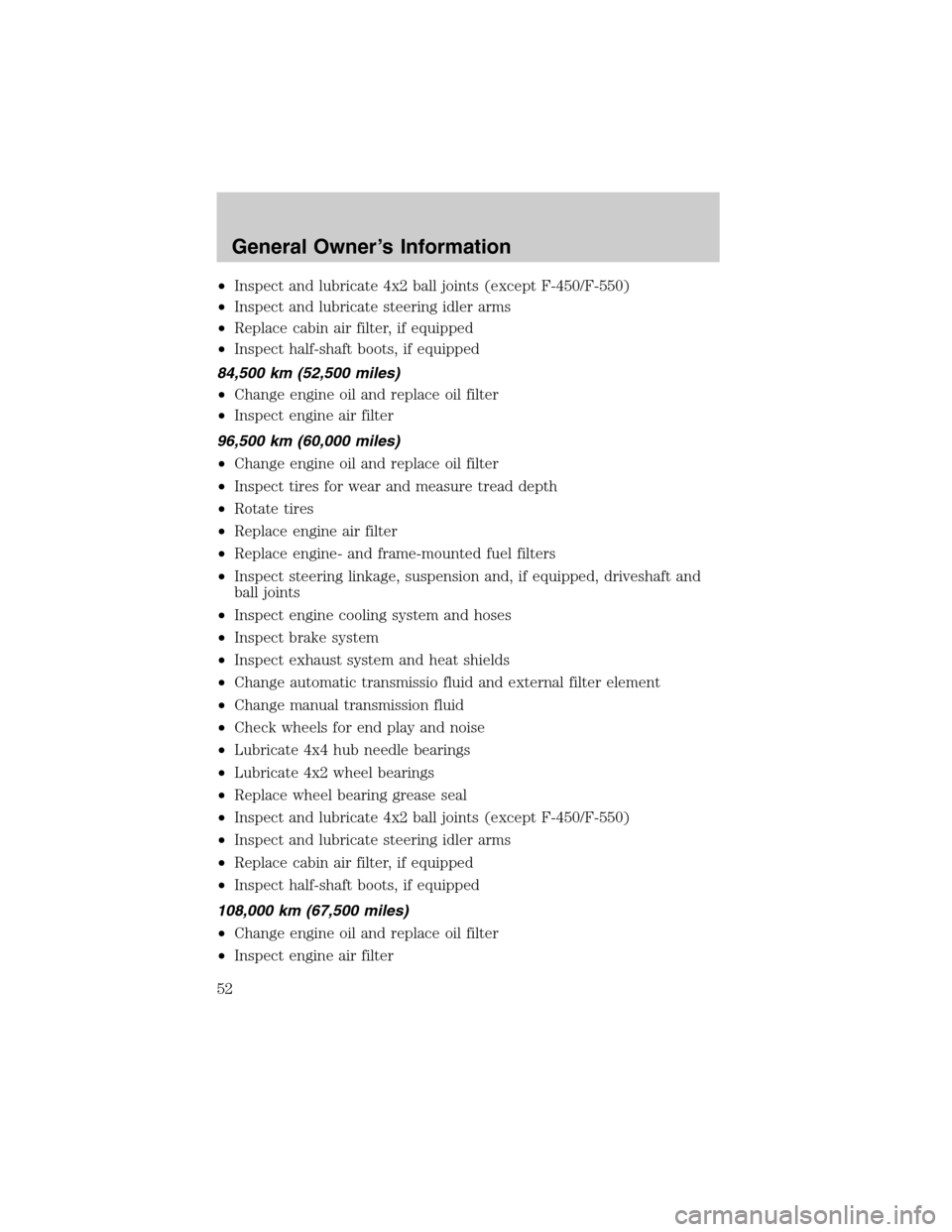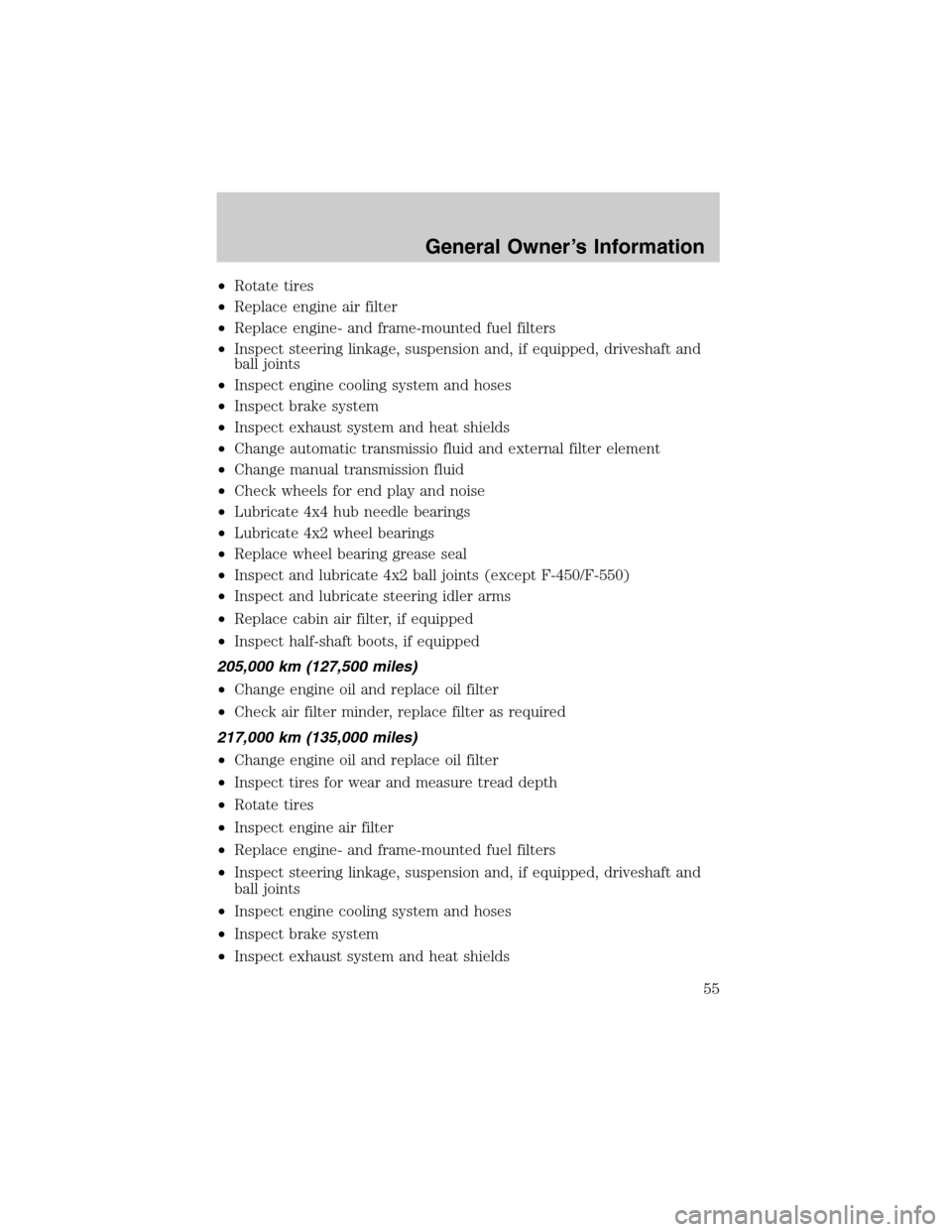Page 20 of 64

F-350 Crew Cab Chassis Cab Single Rear Wheel (Fifth Wheel
Towing)
Engine Rear axle
ratioMaximum GCWR -
kg (lbs.)Maximum
trailer weight -
kg (lbs.)
4x4 with manual transmission
6.0L All 9072 (20000) 5488 (12100)
4x4 with automatic transmission
6.0L All 9072 (20000) 5534 (12200)
F-350 Crew Cab Chassis Cab Dual Rear Wheel (Fifth Wheel
Towing)
Engine Rear axle
ratioMaximum GCWR -
kg (lbs.)Maximum
trailer weight -
kg (lbs.)
4x2 with manual transmission
6.0L All 9072 (20000) 5534 (12200)
4x2 with automatic transmission
6.0L All 9072 (20000) 5579 (12300)
4x4 with manual transmission
6.0L All 9072 (20000) 5306 (11700)
4x4 with automatic transmission
6.0L All 9072 (20000) 5352 (11800)
F-450
Engine Rear axle
ratioMaximum GCWR -
kg (lbs.)Maximum
trailer weight -
kg (lbs.)
Regular Chassis Cab 4x2 with manual transmission
6.0L All 11793 (26000) 8163 (18000)
Regular Chassis Cab 4x2 with automatic transmission
6.0L All 11793 (26000) 8210 (18100)
Regular Chassis Cab 4x4 with manual transmission
6.0L All 11793 (26000) 8027 (17700)
Driving tips
20
Page 21 of 64

F-450
Engine Rear axle
ratioMaximum GCWR -
kg (lbs.)Maximum
trailer weight -
kg (lbs.)
Regular Chassis Cab 4x4 with automatic transmission
6.0L All 11793 (26000) 8074 (17800)
SuperCab Chassis Cab 4x2
6.0L All 11793 (26000) 8029 (17700)
SuperCab Chassis Cab 4x4
6.0L All 11793 (26000) 7847 (17300)
Crew Cab Chassis Cab 4x2
6.0L All 11793 (26000) 7938 (17500)
Crew Cab Chassis Cab 4x4
6.0L All 11793 (26000) 7802 (17200)
F-550
Engine Rear axle
ratioMaximum GCWR -
kg (lbs.)Maximum
trailer weight -
kg (lbs.)
Regular Chassis Cab 4x2
6.0L All 11793 (26000) 8165 (18000)
Regular Chassis Cab 4x4 with manual transmission
6.0L All 11793 (26000) 7981 (17600)
Regular Chassis Cab 4x4 with automatic transmission
6.0L All 11793 (26000) 8029 (17700)
SuperCab Chassis Cab 4x2
6.0L All 11793 (26000) 8029 (17700)
SuperCab Chassis Cab 4x4
6.0L All 11793 (26000) 7802 (17200)
Crew Cab Chassis Cab 4x2 with manual transmission
6.0L All 11793 (26000) 7893 (17400)
Crew Cab Chassis Cab 4x2 with automatic transmission
6.0L 4.88 11793 (26000) 7891 (17400)
Driving tips
21
Page 22 of 64
F-550
Engine Rear axle
ratioMaximum GCWR -
kg (lbs.)Maximum
trailer weight -
kg (lbs.)
6.0L (with
high
capacity
trailer tow
package)4.88 13608 (30000) 9705 (21400)
Crew Cab Chassis Cab 4x4 with manual transmission
6.0L All 11793 (26000) 7709 (17000)
Crew Cab Chassis Cab 4x4 with automatic transmission
6.0L All 11793 (26000) 7756 (17100)
Driving tips
22
Page 40 of 64

IF THE ENGINE WON’T CRANK
Turn on the headlights. If the lights are dim, do not go on at all or if
when the ignition is turned to START the lights become dim or go out,
the battery connections may be loose or corroded, or the battery may be
discharged. If there is a clicking or stuttering sound coming from the
engine compartment when you turn the key to START, this may also
indicate a loose or corroded battery connection.
Check the battery connections at the battery posts, cable connection to
the engine grounding point and at the starter connection.
If a discharged battery is suspected, have it checked and corrected.
•For vehicles with manual transmissions, the clutch pedalmustbe fully
depressed in order for the starter to operate.
•For vehicles with automatic transmissions, the gearshift lever must be
in Park or Neutral in order for the starter to operate.
•Try operating the starter switch several times. Should the switch be
corroded, this operation may clean the contacts or make the switch
temporarily operable until you can reach the dealer.
•If all electrical connections are tight and you need assistance to start,
seeJump Startingin theRoadside emergencieschapter of your
owner guide.
IF ENGINE CRANKS BUT WON’T START
Prolonged starter cranking (in excess of 30 seconds) could cause
damage to the starter motor.
•Check the fuel gauge. You may be out of fuel. If the gauge shows that
there is fuel in the tank, the trouble may be in the electrical system or
the fuel system. If equipped with an auxiliary tank, be sure that the
tank control switch is set for the tank with fuel and not on an empty
tank.
•Leaving the ignition key ON for over two minutes without starting may
make starting difficult because the glow plugs will cease activation.
Reset the system by turning the ignition key to OFF and then back to
ON again.
Minor troubleshooting guide
40
Page 42 of 64
REFILL CAPACITIES
Component Capacity
Cooling system126.0L (27.5 quarts)
Engine oil214.2L (15.0 quarts)
Fuel tank (F-250/350/450/550) Refer to Owner Guide
Fuel tank (Excursion) 166.6L (44.0 gallons)
Radiator cap 110 kPa (16 psi)
Manual transmission
35.5L (5.8 quarts)
Automatic transmission Refer to Owner Guide
1Includes heater and 4.7L (5 quarts) in coolant recovery.
2Includes 1.0L (1 quart) in engine oil filter.
3Use Motorcraft MERCON�ATF, Motorcraft part number XT-2–QDX,
meeting Ford specification MERCON�.
BULB SPECIFICATIONS
Lamp descriptionNumber of bulbs
requiredTrade number
Wait to Start Light 1 194
Water-in-Fuel Light 1 194
Engine Temp. Light 1 194
Capacities and specifications
42
Page 43 of 64
LUBRICANT AND MAINTENANCE MATERIALS SPECIFICATIONS
ItemFord Part
NameFord Part
NumberFord
Specification
Engine OilMotorcraft Motor
Oil 15W40 Super
Duty, 10W30
Super Duty
1
XO-15W40-QSD,
XO-10W30-QSDWSS-M2C171-D,
CI-4/SL, DHD-1
Engine Oil Filter
(Use this filter
Only)-3C3Z-6731–AA
(FL–2016)-
Air Filter
2- FA-1680 ES-E95AE-9601-AA
Battery (2
Required)- BXT-65-750 -
Engine coolant Motorcraft
Premium Gold
Engine Coolant
(yellow-colored)VC-7–A WSS-M97B51–A1
Manual
TransmissionMotorcraft
MERCON�AT FXT-2–QDX MERCON�
1Refer to the engine oil specification chart located underEngine oil
specificationsin theGeneral maintenance informationchapter.
2Always use the authorized Motorcraft air filter listed.Failure to use
the correct air filter may result in severe engine damage.
Capacities and specifications
43
Page 52 of 64

•Inspect and lubricate 4x2 ball joints (except F-450/F-550)
•Inspect and lubricate steering idler arms
•Replace cabin air filter, if equipped
•Inspect half-shaft boots, if equipped
84,500 km (52,500 miles)
•Change engine oil and replace oil filter
•Inspect engine air filter
96,500 km (60,000 miles)
•Change engine oil and replace oil filter
•Inspect tires for wear and measure tread depth
•Rotate tires
•Replace engine air filter
•Replace engine- and frame-mounted fuel filters
•Inspect steering linkage, suspension and, if equipped, driveshaft and
ball joints
•Inspect engine cooling system and hoses
•Inspect brake system
•Inspect exhaust system and heat shields
•Change automatic transmissio fluid and external filter element
•Change manual transmission fluid
•Check wheels for end play and noise
•Lubricate 4x4 hub needle bearings
•Lubricate 4x2 wheel bearings
•Replace wheel bearing grease seal
•Inspect and lubricate 4x2 ball joints (except F-450/F-550)
•Inspect and lubricate steering idler arms
•Replace cabin air filter, if equipped
•Inspect half-shaft boots, if equipped
108,000 km (67,500 miles)
•Change engine oil and replace oil filter
•Inspect engine air filter
General Owner’s Information
52
Page 55 of 64

•Rotate tires
•Replace engine air filter
•Replace engine- and frame-mounted fuel filters
•Inspect steering linkage, suspension and, if equipped, driveshaft and
ball joints
•Inspect engine cooling system and hoses
•Inspect brake system
•Inspect exhaust system and heat shields
•Change automatic transmissio fluid and external filter element
•Change manual transmission fluid
•Check wheels for end play and noise
•Lubricate 4x4 hub needle bearings
•Lubricate 4x2 wheel bearings
•Replace wheel bearing grease seal
•Inspect and lubricate 4x2 ball joints (except F-450/F-550)
•Inspect and lubricate steering idler arms
•Replace cabin air filter, if equipped
•Inspect half-shaft boots, if equipped
205,000 km (127,500 miles)
•Change engine oil and replace oil filter
•Check air filter minder, replace filter as required
217,000 km (135,000 miles)
•Change engine oil and replace oil filter
•Inspect tires for wear and measure tread depth
•Rotate tires
•Inspect engine air filter
•Replace engine- and frame-mounted fuel filters
•Inspect steering linkage, suspension and, if equipped, driveshaft and
ball joints
•Inspect engine cooling system and hoses
•Inspect brake system
•Inspect exhaust system and heat shields
General Owner’s Information
55